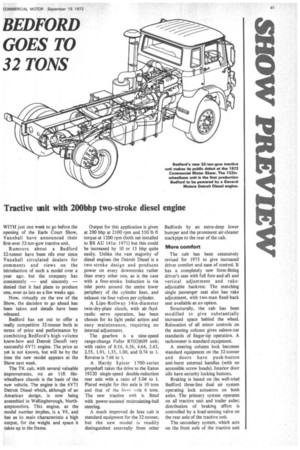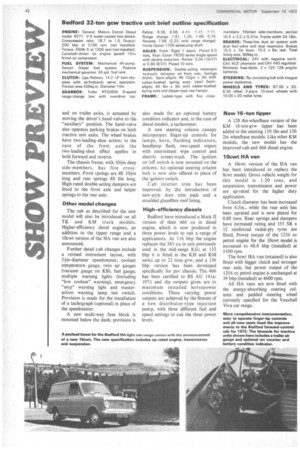BEDFORD GOES TO 32 TONS
Page 43

Page 44

If you've noticed an error in this article please click here to report it so we can fix it.
Tractive unit with 200bhp two-stroke diesel engine
WITH just one week to go before the opening of the Earls Court Show, Vauxhall have announced their first-ever 32-ton-gcw tractive unit.
Rumours about a Bedford 32-tonner have been rife ever since Vauxhall circulated dealers for comments and views on the introduction of such a model over a year ago, but the company has consistently — and sincerely — denied that it had plans to produce one, even as late as a few weeks ago.
Now, virtually on the eve of the Show, the decision to go ahead has been taken and details have been released.
Bedford has set out to offer a really competitive 32-tonner both in terms of price and performance by combining Bedford's high-volume know-how and Detroit Diesel s very successful 6V71 engine. The price as yet is not known, but will be by the time the new model appears at the Show next week.
The TK cab, with several valuable improvements, on an lift Oinwheelbase chassis is the basis of the new vehicle. The engine is the 6V71 Detroit Diesel which, although of an American design, is now being assembled in Wellingborough, Northamptonshire. This engine, as the model number implies, is a V6, and has as its main characteristic a high output, for the weight and space it takes up in the frame.
Output for this application is given at 200 bhp at 2100 rpm and 550 lb ft torque at 1200 rpm (both net installed to BS AU 141a: 1971) but this could be increased by 10 or 15 bhp quite
easily. Unlike the vast majority of diesel engines the Detroit Diesel is a two-stroke design and produces power on every downstroke rather than every other one, as is the case with a four-stroke. Induction is via inlet ports around the entire lower periphery of the cylinder liner, and exhaust via four valves per cylinder.
A Lipe-Rollway 14in-diameter twin-dry-plate clutch, with air /hydraulic servo operation, has been chosen for its light pedal action and easy maintenance, requiring no internal adjustment.
The gearbox is a nine-speed range-change Fuller RT(0)609 unit; with ratios of 8.56, 6.56, 4.64, 3.43, 2.55, 1.91, 1.35, 1.00, and 0.74 to 1. Reverse is 7.66 to 1.
A Hardy Spicer 1700-series propshaft takes the drive to the Eaton 19320 single-speed double-reduction rear axle with a ratio of 5.04 to 1. Plated weight for this axle is 10 tons and that of the front :-nde 6 tons. The new tractive unit is fitted with power-assisted recirculating-ball steering.
A much improved de luxe cab is standard equipment for the 32-tonner, but the new model is readily distinguished externally from other Becifords by an extra-deep lower bumper and the prominent air-cleaner stackpipe to the rear of the cab.
More comfort The cab has been extensively revised for 1973 to give increased driver comfort and ease of control. It has a completely new form-fitting driver's seat with full fore-and-aft and vertical adjustment and rakeadjustable backrest. The matching single passenger seat also has -rake adjustment, with two-man fixed-back seat available as an option.
Structurally, the cab has been modified to give substantially increased space behind the wheel. Relocation of all minor controls on the steering column gives saloon-car standards of finger-tip operation. A tachometer is standard equipment.
A steering column lock becomes standard equipment on the 32-tonner and doors have push-button anti-burst external handles (with no accessible screw heads). Interior door sills have security locking buttons.
Braking is based on the well-tried Bedford three-line dual air system operating lock actuators on both axles. The primary system operates on all tractive unit and trailer axles; distribution of braking effort is controlled by a load-sensing valve on the rear axle of the tractive unit.
The secondary system, which acts on the front axle of the tractive unit and on trailer axles, is actuated by moving the driver's hand-valve to the "auxiliary" position. The hand-valve also operates parking brakes on both tractive unit axles. The wheel brakes have two-leading-shoe action; in the case of the front axle the two-leading-shoe effect applies in both forward and reverse.
The chassis frame, with 104in deep side-members, has five crossmembers. Front springs are 41t 1O--in long and rear springs 4ft 61n long. High-rated double-acting dampers are fitted to the front axle and helper springs to the rear axle.
Other model changes The cab as described for the new model will also be introduced on all TK and KM truck models. Higher-efficiency diesel engines, an addition to the tipper range and a lOcwt version of the HA van are also announced.
Further detail cab changes include a revised instrument layout, with 54in-diameter speedometer, coolant temperature gauge, twin air gauges (vacuum gauge on KB), fuel gauge, multiple warning lights (including "low coolant" warning), emergency "stop" warning light and masteraction warning lamp test switch. Provision is made for the installation of a tachograph (optional) in place of the speedometer.
A new multi-way fuse block is mounted below the dash; provision is also made for an optional battery condition indicator and, in the case of diesel models, a tachometer.
A new steering column canopy incorporates finger-tip controls for lamps, horn, flashing indicators, headlamp flash, two-speed wipers with intermittent wipe control and electric screen-wash. The ignition on /off switch is now mounted on the column. An optional steering column lock is now also offered in place of the ignition switch.
Cab interior trim has been improved, by the introduction of new-style door trim pads and a moulded glassfibre roof lining.
High-efficiency diesels Bedford have introduced a Mark II version of their 466 cu in diesel engine, which is now produced in three power levels to suit a range of applications. At 116 bhp the engine replaces the'381 cu in unit previously used in, the mid-range KG; at 133 bhp it is fitted in the KH and KM series up to 22 tons gvw, and a 136 bhp version has been developed specifically for psv chassis. The 466 has been certified to BS AU 141a: 1971 and the outputs given are to maximum installed horsepower conditions. These varying power outputs are achieved by the fitment of a new distributor-type injection pump, with three different fuel and speed settings to suit the three power levels. New 16-ton tipper A 12ft 4in-wheelbase version of the KM 16-ton-gvw tipper has been added to the existing lift Oin and 13ft 2in wheelbase models. Like other KM models, the new model has the improved cab and 466 diesel engine.
10cwt HA van A lOcwt version of the HA van has been introduced to replace the 8cwt model. Gross vehicle weight for this model is 1.30 tons, and suspension, transmission and power are up-rated for the higher duty application.
Clutch diameter has been increased from 6.5in., while the rear axle has been uprated and is now plated for 0.88 tons. Rear springs and dampers have increased rating and 155 SR x 12 reinforced radial-ply tyres are fitted. Power output of the 1256 cc petrol engine for the lOcwt model is increased to 48.8 bhp (installed) at 5100 rpm.
The 6cwt HA van (retained) is 'also fitted with bigger clutch and stronger rear axle, but power output of the 1256 cc petrol engine is unchanged at 39 bhp (installed) at 4600 rpm.
All HA vans are now fitted with the energy-absorbing steering column and padded steering wheel currently specified for the Vauxhall Viva car range.
























































































































